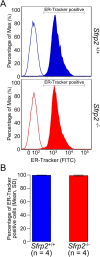The defect of SFRP2 modulates an influx of extracellular calcium in B lymphocytes
- PMID: 25370898
- PMCID: PMC4242488
- DOI: 10.1186/1756-0500-7-780
The defect of SFRP2 modulates an influx of extracellular calcium in B lymphocytes
Abstract
Background: In the Wnt pathway, the secreted frizzled-related protein 2 (SFRP2) is thought to act as one of the several competitive inhibitors of Wnt. However, the precise role of SFRP2 is still poorly understood especially in B lymphocytes. Here, we investigated the function of SFRP2, comparing the SFRP2 defective as well as normal B lymphocytes in mice.
Results: We demonstrated that calcium influx from extracellular to intracellular space in splenic B cells was clearly affected by the defect of SFRP2. In addition, the phosphorylation of phospholipase Cγ2 was observed to be reduced in SFRP2 defective splenic B cells with B cell receptor stimulation.
Conclusions: SFRP2 is suggested to modulate the influx from extracellular calcium in the B cell receptor signaling pathway.
Figures




References
Publication types
MeSH terms
Substances
LinkOut - more resources
Full Text Sources
Other Literature Sources

